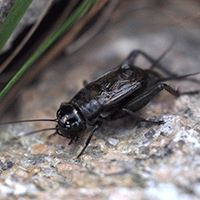
Crickets

Crickets are a type of insect that are often mistaken for grasshoppers because of their long, slender legs that allow them to jump. There are a wide variety of cricket species that live across the country; and some of those species live right here in New England. Crickets are usually nocturnal and can be found hiding out during the day in warm, moist locations in interior and exterior spaces.
Cricket Identification
There are three common species of cricket in our area - the house cricket, the field cricket, and the camel cricket. The house cricket is yellowish-brown and has 3 distinctive dark bands going across its head. House crickets have wings that are pointed at their ends, and their bodies can range in size from 3/4 to 7/8th of an inch. Field crickets are generally black but can be brown or a “straw” color. Adults grow to be between 1/2 and 1 1/8th of an inch in length. The wings on adults lay flat against their back and are rounded on the ends. Camel crickets are light brown to dark brown and have some dark banding on their bodies. Adults can range in size from 1/2 - 1 1/2 inches in length. Camel crickets have enlarged hind legs, long antennae, and are wingless. As their name suggests, they have a humpbacked appearance.
Habits & Life Cycle Of Crickets
Crickets have a three-stage lifecycle: egg, nymph, and adult. Females deposit their eggs in damp organic materials where the nymphs hatch and develop into adults. Crickets are nocturnal and typically live outside scavenging on decaying organic materials including plant matter and very young plants. As the temperature begins to fall in the late fall months, they will look to move inside homes and other buildings where they can more easily find warm shelter, moisture, and food sources. Inside, they can be found living in the humid areas of your home like basements, behind wall voids, in crawl spaces, underneath sinks, and in laundry rooms. Both field cricket and house cricket males use their wings to create the typical cricket “chirp” that they are known for; it is important to note, though, that not all crickets chirp; the camel cricket does not produce sound.

Trust Massachusetts' oldest family owned pest control company to protect your family & home.